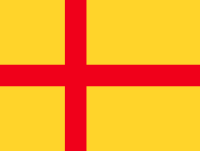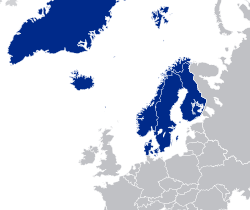- Nordisk Vision
-
Nordisk Vision
Pohjoismainen Visio(Finnish)
Nordisk Vision use the Nordic flag as its symbol, originally being the flag of the medieval Scandinavian union, the Kalmar Union.
Formation May 17, 2001 Type International organisation Official languages Swedish, Danish, Norwegian, Finnish, Icelandic, Faroese, Greenlandic and Sami Website http://www.nordiskvision.org Nordisk Vision (Danish/Norwegian/Swedish: Nordisk Vision, Finnish: Pohjoismainen Visio) is a NGO dedicated to closer cooperation between the Nordic countries and ultimately accomplishing the creation of a democratic federation of autonomous regions – a united Scandinavian state.
The organisation was founded on May 17, 2001, at Voksenåsen in Oslo, Norway. However, since 2004, the association formally consists of independent associations for each country, as there appeared to be too many legal border barriers associated with having one common pan-Nordic association.
Membership is open to world-wide sympathisers and the organisation strongly distance it selves from extremist and racist groups. Nordisk Vision claims to have no ideological connections beyond the desire for a Nordic union and several of the members are also stated to be active in other pro-Nordic NGOs, such as Foreningen Norden.
Contents
Background
The kingdoms of Denmark, Norway, Sweden and their then territories were all united in the Kalmar Union under Margaret I on June 17, 1397. A series of personal unions kept it alive up until the election of Gustav Vasa as king of Sweden in 1523, which led to a de facto split.
The following centuries were marked by Nordic wars, but vibrant economic ties and population flows across the borders were maintained. The 19th century saw a strong political and cultural regional movement developing in the Nordic countries, Scandinavism. This advocated a military defence pact and a new Nordic union, similar to what was established in Germany and Italy. One of the outcomes of the movement was the Scandinavian monetary union created in 1871. This cooperation lasted until World War I, when the one-to-one pegging was scrapped. In the aftermath of World War II, negotiations on possible deeper military and economic integration were revitalised (See e.g. Nordek). One of the many concrete outcomes of this process was the Nordic Passport Union. Complete integration were close to realisation, but were then abruptly abandoned as a consequence of the cold war.[1][2][3] Since the collapse of the Sovjet Union the efforts to cooperate between the Nordic countries have once again increased; this time often including the baltic countries in the dialogue as well.[4] An example of the latter is the Nordic Investment Bank (NIB).
One of many indicators of a positive shift in attitudes towards further Nordic cooperation is Thorvald Stoltenberg's February 2009 report to the Nordic foreign ministers, "Nordic co-operation on foreign- and defence policy".[5] The idea of a Nordic/Scandinavian Federation has recently received more attention in Nordic media. The historian Gunnar Wetterberg's proposal of a union in one of the bigger Swedish daily papers, Dagens Nyheter (October 27, 2009), gave widespread attention in Nordic media. Wetterberg (and Stoltenberg) argued that it would give member countries more influence if they combined their voices on the world stage. The five countries, if combined, would have the world's tenth largest economy; larger than e.g. Russia or Brazil.[6]
The Vision
The organisation strive to further integrate the Nordic countries (Sweden, Denmark, Norway, Finland, Iceland, Greenland, Faroe Islands and Åland ) and to create a Nordic federation or a union. The countries have a long common history and the societies display many common characteristics. Nordisk Vision argues that the historical, social, economical, cultural and political backgrounds of the countries is what constitutes the very special relationship between the peoples. A solid foundation on which a deeper integration and more cooperation in general can be based. These arguments are supported by the strong correlation seen in many global comparative studies on cultural and moral values,[7][8][9] stated to display low Psychic Distance in-between.
The old red and yellow Nordic flag, in medieval times used as the symbol for the Kalmar Union, is currently used as the symbol for Nordisk Vision. The association does not want to eliminate national symbols from the various countries and regions but do promote the development of a more clear Nordic identity. The organisation believes that the future Nordic federation should be a decentralised state with strong regions. Increasing the degree of direct democracy and transferring power from the national level to regional level as well as the supranational Nordic level. Thus improving local influence for citizens and at the same time strengthening the supranational Nordic cooperation; creating a stronger Nordic identity.
Nordic Vision perceives EU as a political issue which it prefer not to take a clear stand either for or against, as long as the development of the European Union does not conflict with the organisations long term integration goals for the Nordic countries. Many of the members are skeptical towards the European Union and oppose further integration on the European level, preferring a Nordic alternative.[10]
Sources
- http://www.nordiskvision.org Nordisk Vision
References
- ^ Nordic Council: The history of Nordic Co-operation - 1953–1971 Many plans and initiatives, little progress.
- ^ Stampehl, Jan (2001): Ist Finnland ein nordisches Land? Der Nordek-Prozess 1968–70 als Fallstudie, Chapter 3 - Die Nordek-Verhandlungen. Masters Thesis at Philosophische Fakultät II, Humboldt-Universität, Berlin, Germany. (In German)
- ^ European Tribune: A Nordic Union (That Wasn't), Mar 30th, 2008.
- ^ Nordic Council: History of the Nordic region - Five welfare states in a global world (approx. 1920 to the present)
- ^ Stoltenberg, Thorvald: Nordisk samarbeid om utenriks- og sikkerhetspolitikk, February 9th, 2009. (In Norwegian]
- ^ Wetterberg, Gunnar: De fem nordiska länderna bör gå ihop i en ny union , Dagens Nyheter, October 27th, 2009 . (In Swedish)
- ^ Hofstede, Geert (1980): Cultures consequences: international differences in work-related values. Beverly Hills, USA: Sage.
- ^ Ronen, S., & Shenkar, O. (1985): Clustering countries on attitudinal dimensions: a review and synthesis. Academy of Management Review, 10(3): 435-454. JSTOR
- ^ Gupta, Vipin, Paul J. Hanges & Peter Dorfman (2002): Cultural clusters: methodology and findings. Journal of World Business, 37: 11-15.
- ^ Nordisk Vision: Official homepage of the organisation.
External links
Gunnar Wetterberg reviewed:
Categories:
Wikimedia Foundation. 2010.
